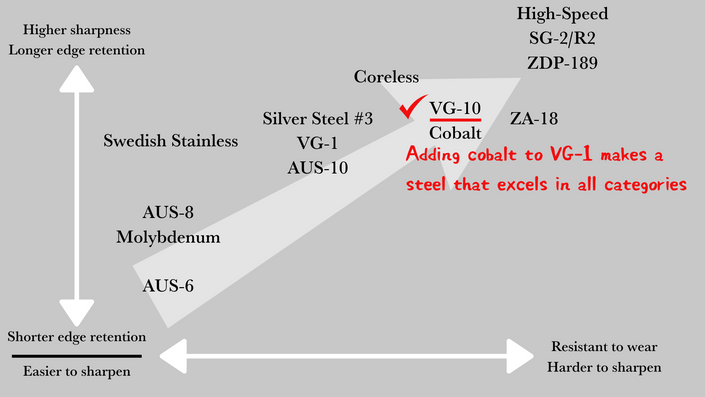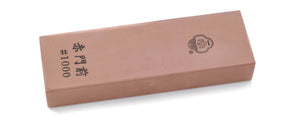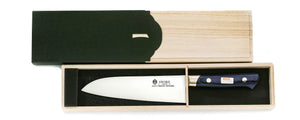
A Stainless Japanese Knife with a luxurious lacquer coating handle
A masterpiece of combination between two different Japanese traditional skills proudly presented: knife making and lacquering.
- Blade: VG10 Stainless Steel; Sharp and long edge retention, easy to sharpen, rust resistant.
- Handle: Suzuchirashi; Urushi Lacquered, accented with tin and reinforced with brass.
| Product number | Actual Blade Length (mm) | Full Length (mm) | Total Weight (g) |
|---|---|---|---|
| 1kb3 | 170 | 310 | 135 |
| Blade | Material Name | Handle |
|---|---|---|

Double Edged |
VG-10 | Urushi Finish Handle |

Wa-Santoku
A Wa-Santoku is typically used in households around Japan. Unlike the standard Santoku, the Wa-Santoku has a traditional Japanese handle which shifts the balance point slightly,allowing more nimble cutting.

VG-10
Adding cobalt to VG-1 stainless steel's composition increases its wear resistance and tenacity. The resulting VG-10 stainless steel is also easy to process, making it easy to create well-balanced kitchen knives.
Stainless Steel
VG-10 is one of the most popular stainless steels used in kitchen knives today and is made from carefully selected and high-purity raw materials with good machinability. VG-10 is both hard and tough, while staying easy to resharpen.This combination of factors gives the highly efficient VG-10 a strong advantage over other steels in its field.

Suzuchirashi Urushi Finish Handle
Our suzuchirashi or scattered tin finish refers to a "black urushi" lacquered finish, with powdered tin particles scattered towards the butt of the handle. This is a Japanese traditional coating technique passed down through generations. The octagonal handle is first fully coated with a layer of raw lacquer. Two sides of the handle are then coated with multiple layers of kuroro (black lacquer), with polishing done in between to give the lacquered surface a mirror-like luster. Particles of tin are then added to giving the handle a striking accent and complement its contrast to the blade. This lacquer style is much more resistant to water, and less prone to damage than ordinary wooden handles.

Forge Welded
Forge Welded knives undergo a forging process where steel is heated to high temperatures and then shaped with a hammer. This carefully done process changes the internal structure of the steel, producing a blade with superior hardness levels. Highly skilled craftspeople forge, quench, and create the knife's cutting edge by hand, resulting in a sharp blade with long edge retention.

Optional Engraving
Optional Engraving Service
Sakai Ichimonji provides complimentary engraving using either Japanese Kanji or English Alphabet. Please specify your preference. For details, please visit here
A knife store that has supported the history of knives and food culture in Japan.
It has been 600 years since the birth of swordmaking in the Sakai region of Japan. Sakai Ichimonji Mitsuhide's and it's craftsmen continue to build on that legacy by producing the finest blades in Japan.
This is where the culture of completing a dish of sashimi by "just cutting" and the culture of expressing sharpness as "taste" was born.
For 70 years, we have been connecting the spirit of Sakai's craftsmen with the passion of chefs in Osaka's kitchen equipment shopping district, known as the kitchen of Japan.
We are very happy that our knives can be used by people all over the world.
Precautions
After use, wash off any dirt and wipe thoroughly with a dry cloth to remove any moisture. This product is not for use with frozen foods.This product is handmade, so each piece will be different. Please use the weight and length listed as a guide. Each material is natural and may vary in color. It is not the same as the picture.We take great care with our inventory, but in the unlikely event that we are out of stock, we will contact you by email to let you know.















































